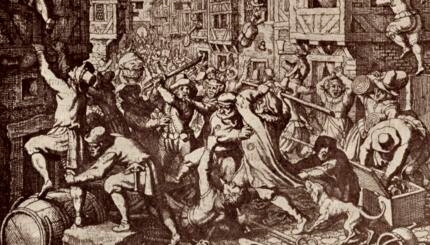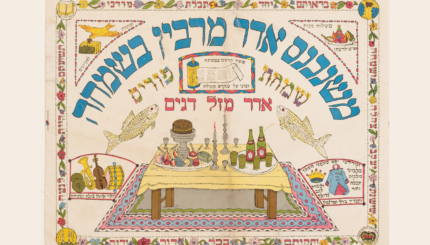“For Haman…had plotted to destroy the Jews, and ha cast a pur (lottery) to terrify and destroy them; but when she (Esther) appeared before the King, he commanded…that the evil scheme which he (Haman) had devised against the Jews, should recoil upon his own head….”
–Megillat Esther, 9:24-25
The Sefer Yetzirah, among other texts, reveals the unique energies, themes and spiritual practices corresponding to each month of the year. When we look into this mystical information on the month of , we can crack the code of Purim…and find out why it is that we are still cracking up today.
 Every holy day has both a narrative (the miracle that happened), and a seasonal context (the time of year when the miracle happened). In a sense, it is the seasonal context that gives rise to the narrative. The spiritual matrix of Adar gives rise to the day of
.
Every holy day has both a narrative (the miracle that happened), and a seasonal context (the time of year when the miracle happened). In a sense, it is the seasonal context that gives rise to the narrative. The spiritual matrix of Adar gives rise to the day of
.

Help us keep Jewish knowledge accessible to millions of people around the world.
Your donation to My Jewish Learning fuels endless journeys of Jewish discovery. With your help, My Jewish Learning can continue to provide nonstop opportunities for learning, connection and growth.
The Letter-Combination of the Month
There are four letters in the name of Hashem (Yud, Hei, Vav, and Hei). Each month of the year has an inner light that is refracted as a different sequence of these four letters. The sequence corresponding with the month of Adar is Hei – Hei – Yud – Vav. This is, in a sense, an inverse image of the name of Hashem. In the design of the normal spelling, there is first a ‘giver’ (Yud), then a ‘receiver’ (Hei); then another ‘giver’ (Vav) and another receiver (Hei). In Adar’s sequence, first come the receivers, followed by the givers.
This reversal reminds us of when Haman’s destructive decree was reversed. Although the day of Purim was supposed to be when we would receive our end and demise, we came out on top. The day was transformed into a joyful festival of giving gifts.
The Letter of the Month
The alphabetical letter corresponding to Adar is Kuf.
Kuf represents kedushah, ‘holiness.’ Yet, the word kuf means ‘monkey’–bringing up images of play and mockery. Similarly, the Zohar says the letter Kuf represents imitation. That is, Kuf imitates the letter Hei, the only other letter that has two separate lines in its graphic design.
Kuf represents ‘earthly kingship,’ whereas Hei represents the ‘Divine kingship.’ It may seem that the earthly plane is ruled by randomness and chaos and mockery, and that the Divine has hidden its face. However, Purim teaches us that despite these appearances, the Holy One can reveal the ever-existing Divine kingship, at any time. To see the miraculous within earthly history, we must see that everything in this world imitates what is in the World Above.
On Purim, many have a custom of dressing in costume, hiding their identity behind masks, or playfully imitating others. When your earthly identity is altered, it can be easier to reveal who you really are.
Sense of the Month
According to the Sefer Yetzirah the ‘sense’ connected with Adar is laughter and merriment. There are two kinds of laughter. Nervous laughter expresses the feeling that life is meaningless or alienating. This reinforces depression and limited perception. Holy laughter, on the other hand, expresses the recognition that everything paradoxically makes sense. Both tragedy and comedy can pull the rug out from under our mind. When we respond to life with holy laughter, we can joyful release ourselves from limitation.
The word s’chok (laughter) has a numerical value of 414, the same as the term Or Ein Sof, ‘Infinite Light.’ This tells us that through holy laughter a person can rise above the world of form and perceive the Light of the Infinite One.
Astrological Sign of the Month
The zodiac influence for this month is Dagim, meaning ‘fish’ or Pisces. Fish are hidden from us. This reminds us of the hidden miracle of the Purim story.
The word dag as in fish alludes to da’aga, ‘worry.’ This shows us that as Adar progresses our spiritual practices should involve overcoming our tendency to worry. We worry because we feel uncertain. The way to overcome worry, then, is to find certainty and deeper to allow our uncertainties to elevate and free us and thus bring us joy.
Tribe of the Month
The tribe of Adar is Naftali. blessed his son Naftali to be an “ayalah shelucha,” a swift deer. Indeed, the tribe of Naftali inherited this trait of alacrity. Worry and doubt weigh you down physically, but to be ‘light on your feet’ is to embody an emotional and mental lightness or flexibility. These are the traits that allow us to tolerate paradox, while dancing joyfully through life.
Body Part of the Month
The body part corresponding to Adar is the tehol, spleen. According to the , this organ is connected with laughter. The Zohar, on the other hand, suggests that the spleen is connected with depression, atzvus. Reb Tzadok seems to reconcile these ideas: “Shallow laughter brings about depression.” It’s interesting to note that many professional comedians have suffered from depression.
Deep, pure laughter comes through yirah, ‘awe.’ A surprising or incongruous shift in perception can produce a subtle sense of divine awe, a stopping of the mind…and perhaps a healthier spleen.
Time of the Year
Adar comes in the very beginning of Spring. During the Winter months, people spend more time indoors, and many become more introverted. They cover their bodies with many layers of clothing, and some tend to gain weight as well. When Spring comes and people come out of hiding, there may be relief, but there also can be a sense of self- doubt: ‘Who am I? How do I appear to others?’
Name of the Month
The name Adar is 205, the numerical value of the words b’hesed m’chusa, ‘with hidden kindness.’ The kindness of Hashem is hidden within the Purim story. At the time, things seemed very uncertain and difficult. Only in retrospect could the kindness be perceived.
Adar means strong, that which is solid and firm, the idea of certainty. And yet the letters of the name Adar are an acronym for Reisha D’lo Ityada, ‘the Unknowable Head’ or ‘the head that does not know.’ This refers to a level of reality within the sefirah of Keser of Atzilut (‘Crown of Nearness’). This level is so deep and so hidden, it cannot be known by any being, even itself, so-to-speak. It is as if the Everpresence is hiding from Itself. This is the paradox of paradoxes.
Because Keser is beyond all forms and definitions, it can contain impossibilities and paradoxes, without needing to resolve them. In Keser, everything is possible. Haman wanted to uproot us by tapping into the power of Keser. This is why he used a lottery (pur), a tool of randomness, to determine when to establish his decree against us. When the lottery fell on Adar, Haman was glad because he knew that Adar was the month when Moses died. He assumed that we would be uncertain and spiritually weakened. What he didn’t know was that Moses was also born in Adar. In other words, while Haman had access to Keser, he didn’t realize we were already rooted there. Because our not-knowing is rooted in Hashem’s not-knowing, we are spiritually strengthened rather than weakened.
Haman was a descendent of Amalek. The name Amalek has the same numeric value as the word safek, ‘doubt.’ Therefore, Haman symbolizes destructive ‘not-knowing.’ When this force attacks us, it attempts to create fear and destabilize our sense of certainty. However, in our essence, our certainty transcends the normal categories of certainty and uncertainty. From this place we can harness the force of doubt to open our minds to radical new possibilities. On Purim we reach an essence-consciousness called lo yada, a holy ‘not-knowing’, where we can reveal our point of indestructible faith. This is our victory over Haman.
Our Journey through Adar
Not only is Adar the matrix that gives rise to Purim, but every day of Adar sparkles with the light of Purim. The Talmud Yerushalmi suggests that under certain circumstances the unique of Purim–chanting the Megillah–can be fulfilled anytime during Adar, not only on the day of Purim. All throughout the month of Adar, therefore, we can convert nervous laughter into holy laughter, and anxious doubt into holy doubt. The four weeks of Adar can be seen to correspond with the four letters of this month’s letter-combination. This correspondence, in turn, suggests a map of sefirot, spiritual worlds, and finally four stages of spiritual practice and experience:
| Part One
(Rosh Chodesh through the birth/death day of Moses) |
Part Two
(Including the reading of Parshat Zahor, and culminating in the Fast of Esther) |
Part Three
(Beginning with the reading of the Megillah on the night of Purim) |
Part Four
(Completing Adar; looking forward to the Month of Nisan; Parashat haChodesh) |
|
| Letter of Hashem’s Name | Hai | Hai | Yud | Vav |
| Sefirah | Malchut (Kingdom) | Binah (Understanding) | Keser (Crown) | Ze’ir Anpin ((the six sefirot that channel Divine light into Malchut below) |
| Spiritual World | Asiyah (Action) | Beriah (Primal Creation) | Atzilut (Nearness/Oneness) | Yetzirah (Formation) |
| Spiritual Practice/Experience | Working to overcome worries through adding in joy: “When Adar comes in, we increase in joy.” The death day of a tzadik also brings atonement, increasing joy. | Overcoming doubt through a deeper understanding of life, beyond form. Haman/Amalek/doubt is hanged on the 50-foot gallows, representing the formless 50th Gate of Binah, the root of Creation. | Glimpsing the Paradox of Paradoxes, and exploding into the laughter of ‘not-knowing’ or ‘holy doubt’ | Focusing the holy joy and laughter of Purim, and channeling it into the rest of the year |
Reprinted with permission from Iyyun, an institute for the exploration of the deeper dimensions of Torah.



